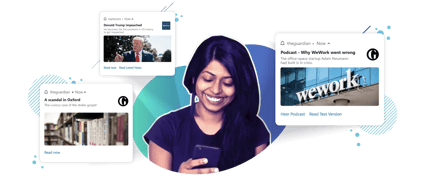Push notifications are a widely adopted solution in the digital publishing industry. As newsroom editors step on the gas to win the publishing race, push notifications are their last-mile dose of gas to pick pace. Editors battle to drive daily traffic to their website and enhance user engagement for the content they publish.
The association is mutual. Breaking news and push notifications are synonymous! The industry is so notoriously time-sensitive, that shipping takes priority. Always. Unfortunately, in this daily rut of publishing, user engagement suffers.
So what has the journey of push notifications been so far? The journey of push began with iOS in 2009. This was followed by Google’s C2DM (cloud to device messaging) in 2010. Web push happened when iOS rolled out web push for Safari in 2013. Chrome rolled out web push in 2015.
 Also read: Web Push Notifications Explained
Also read: Web Push Notifications Explained
After push went mainstream, it gave rise to the second phase of notifications. I'd refer to it as push notifications 2.0. This is when operating systems began curtailing the freedom developers took for granted all along. The approach was to prioritize user experience. Less was now more!
We are currently in the third phase of the push notification journey. We will continue to see a combination of OS-level restrictions with users being offered more control. These changes have been accelerated due to widespread criticism of platforms for not respecting users’ privacy.
The rise of push notifications
The world of push notifications began with web push. With the possibility of engaging audiences, websites of all sizes took on the opportunity. Web push notifications have been the go-to channels for user engagement and driving repeat traffic.
Web Push Notifications
Along the way, Chrome began applying restrictions by curbing sites with lower subscription rates to a quiet notification UI. In case users blocked notification permissions, they started seeing fewer notification prompts. Firefox and Safari followed up by not allowing users to see a prompt immediately on page load.
 Browsers have given more controls to users that include opting out of all push notifications in one go to define the way they should be prompted by websites. Browsers have also started moving w3c standards, which may unify the experience further on different browsers.
Browsers have given more controls to users that include opting out of all push notifications in one go to define the way they should be prompted by websites. Browsers have also started moving w3c standards, which may unify the experience further on different browsers.
Android Push Notifications
Android push notifications channel has been the biggest in terms of scale. Android push notifications have gone through a similar journey. Be it enabling businesses to send notifications using different channels in Android 8 to asking users to opt-in for notifications, Android has started providing more controls to users. In Android 12, the operating system started suppressing notifications from the apps that users don’t interact with often.
iOS Push Notifications
Apple with its recent iOS 15 has started offering options to users to choose from: ‘Allow Immediate Notifications’, ‘Add to Scheduled Summary’, or ‘Don’t Allow’. iOS also uses on-device AI to display notifications in the order of priority based on how often a user interacts with it. Apps developers can also use relevancy scores to get a higher chance of reaching the top of the summary. Users can also set up ‘Focuses’ to automatically filter notifications based on user preferences.
The advent of operating systems
If mobile leads in content consumption, then the landscape is split between Apple and Google with their browser and device portfolios. After widespread concerns about respecting the users' choice, the two smartphone platforms - Android and iOS - have become sensitive to offering any feature that may even remotely be perceived as intrusive.
Apple took on the mantle of going heavily against advertisement-led intrusion. The first victim was cookies. Steve Jobs had dealt a blow to a thriving industry around Flash a decade ago!
With one of the world's most valuable companies making privacy its primary sales pitch, the other had to follow. The recent Android 13 announcement at IO in May 2022 built on that trend.
The future of push notifications
The future is expected to put users in absolute control - rightly so. Features such as push notifications were never meant to be intrusive. However, that's possible only with one key attribute: relevancy. We don't mind being nudged with the content we pursue. That’s the basic premise of a content business, to begin with.
Publishers ought to create content that their audience finds relevant and engaging. In the odd instance when irrelevant content is pushed to us as an audience, it is a natural put-off. That's why platforms are trying to ensure. The onus, therefore, is on creators: be mindful of your audience. Deliver content that they find relevant and they will follow you.
Publishers should engage users responsibly. Instead of spamming them, they should aim to engage with them in a timely manner and focus on increasing the lifetime of users. It’s worth recalling that Content is King. The rules of the game haven’t changed since content creation as a business began. The topmost priority has always been to draw audiences by creating sticky content. And that will continue to be the rule of the game. Notifications are just the messengers, not the message itself.





